Leadership Style and Strategic Implementation in ABC Company Report
VerifiedAdded on 2022/09/08
|25
|6229
|108
Report
AI Summary
This report examines the relationship between leadership styles and their impact on strategic implementation within the ABC Company. It begins with an introduction to the company and the finance sector in Sri Lanka, followed by a literature review defining leadership, its importance, and organizational structure. The report explores transformational and democratic leadership styles. Strategic formulation is discussed, including the importance of strategic management and a PESTEL analysis. The core of the report analyzes the relationship between leadership and strategic management within ABC Company, supported by a SWOT analysis. Recommendations are provided, along with a self-reflection. The report emphasizes the significance of leadership in driving strategic plans, adapting to change, and fostering a culture of sustainability within the organization. It highlights the use of transformational and democratic leadership approaches to achieve the company's goals.
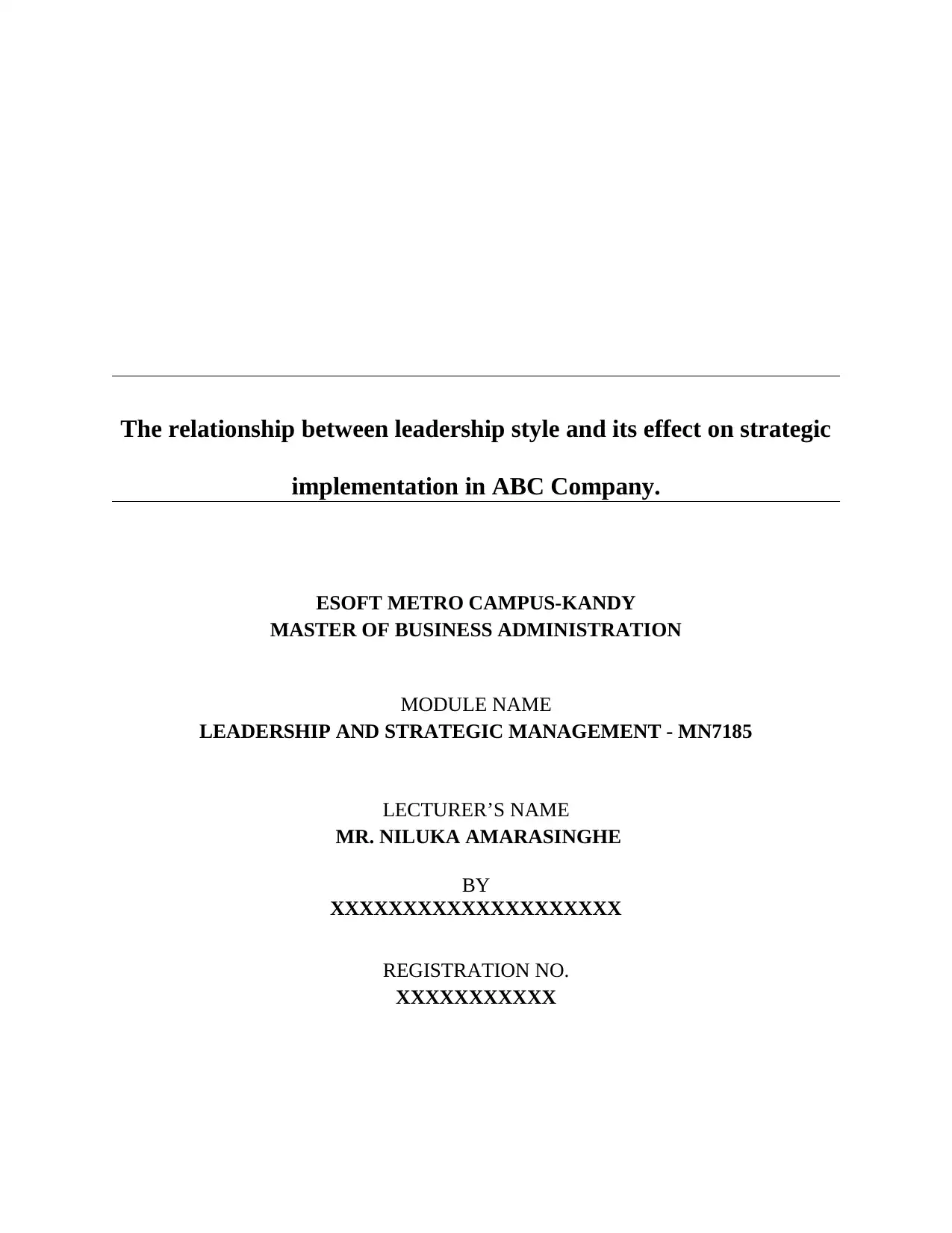
The relationship between leadership style and its effect on strategic
implementation in ABC Company.
ESOFT METRO CAMPUS-KANDY
MASTER OF BUSINESS ADMINISTRATION
MODULE NAME
LEADERSHIP AND STRATEGIC MANAGEMENT - MN7185
LECTURER’S NAME
MR. NILUKA AMARASINGHE
BY
XXXXXXXXXXXXXXXXXXXX
REGISTRATION NO.
XXXXXXXXXXX
implementation in ABC Company.
ESOFT METRO CAMPUS-KANDY
MASTER OF BUSINESS ADMINISTRATION
MODULE NAME
LEADERSHIP AND STRATEGIC MANAGEMENT - MN7185
LECTURER’S NAME
MR. NILUKA AMARASINGHE
BY
XXXXXXXXXXXXXXXXXXXX
REGISTRATION NO.
XXXXXXXXXXX
Paraphrase This Document
Need a fresh take? Get an instant paraphrase of this document with our AI Paraphraser
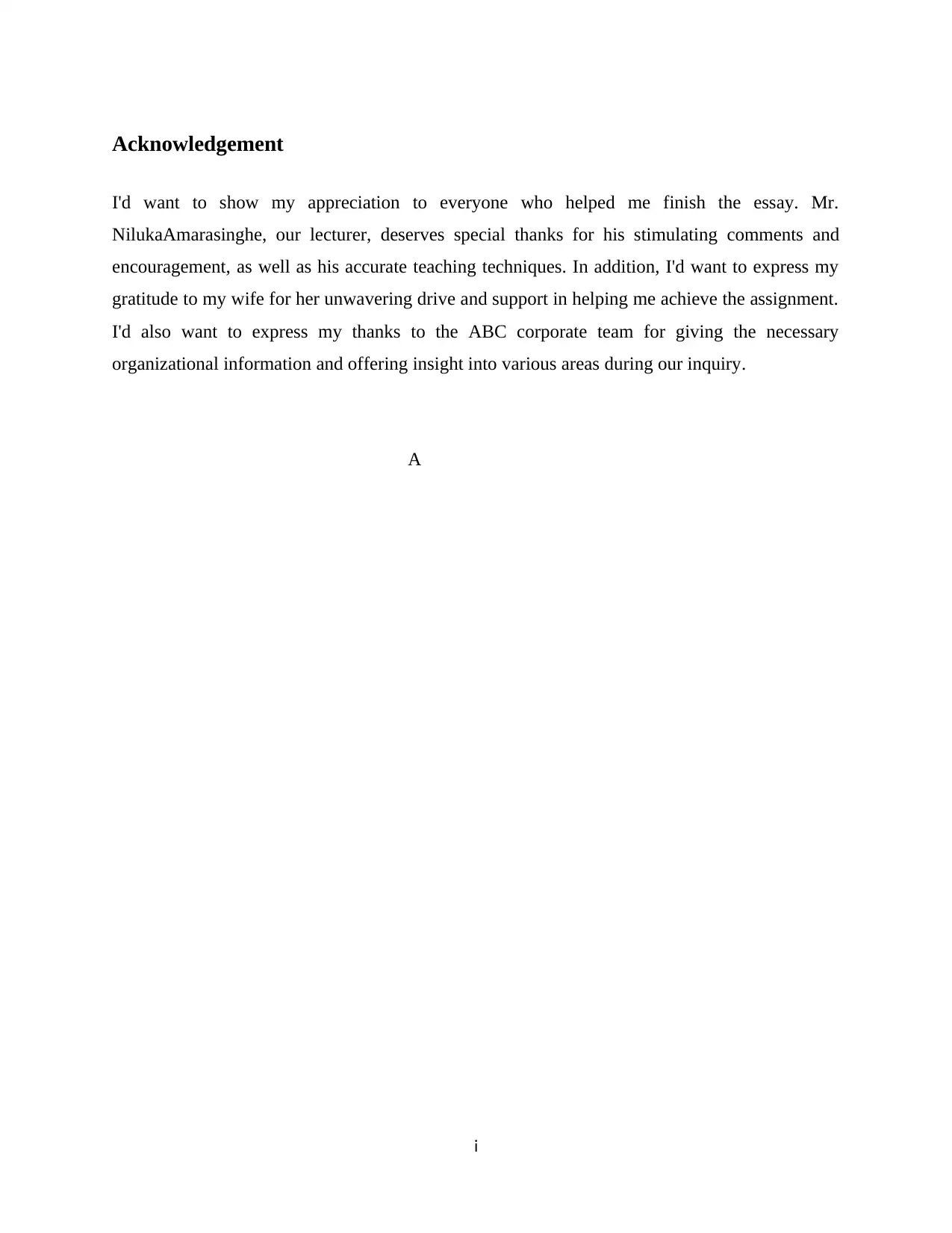
Acknowledgement
I'd want to show my appreciation to everyone who helped me finish the essay. Mr.
NilukaAmarasinghe, our lecturer, deserves special thanks for his stimulating comments and
encouragement, as well as his accurate teaching techniques. In addition, I'd want to express my
gratitude to my wife for her unwavering drive and support in helping me achieve the assignment.
I'd also want to express my thanks to the ABC corporate team for giving the necessary
organizational information and offering insight into various areas during our inquiry.
A
i
I'd want to show my appreciation to everyone who helped me finish the essay. Mr.
NilukaAmarasinghe, our lecturer, deserves special thanks for his stimulating comments and
encouragement, as well as his accurate teaching techniques. In addition, I'd want to express my
gratitude to my wife for her unwavering drive and support in helping me achieve the assignment.
I'd also want to express my thanks to the ABC corporate team for giving the necessary
organizational information and offering insight into various areas during our inquiry.
A
i
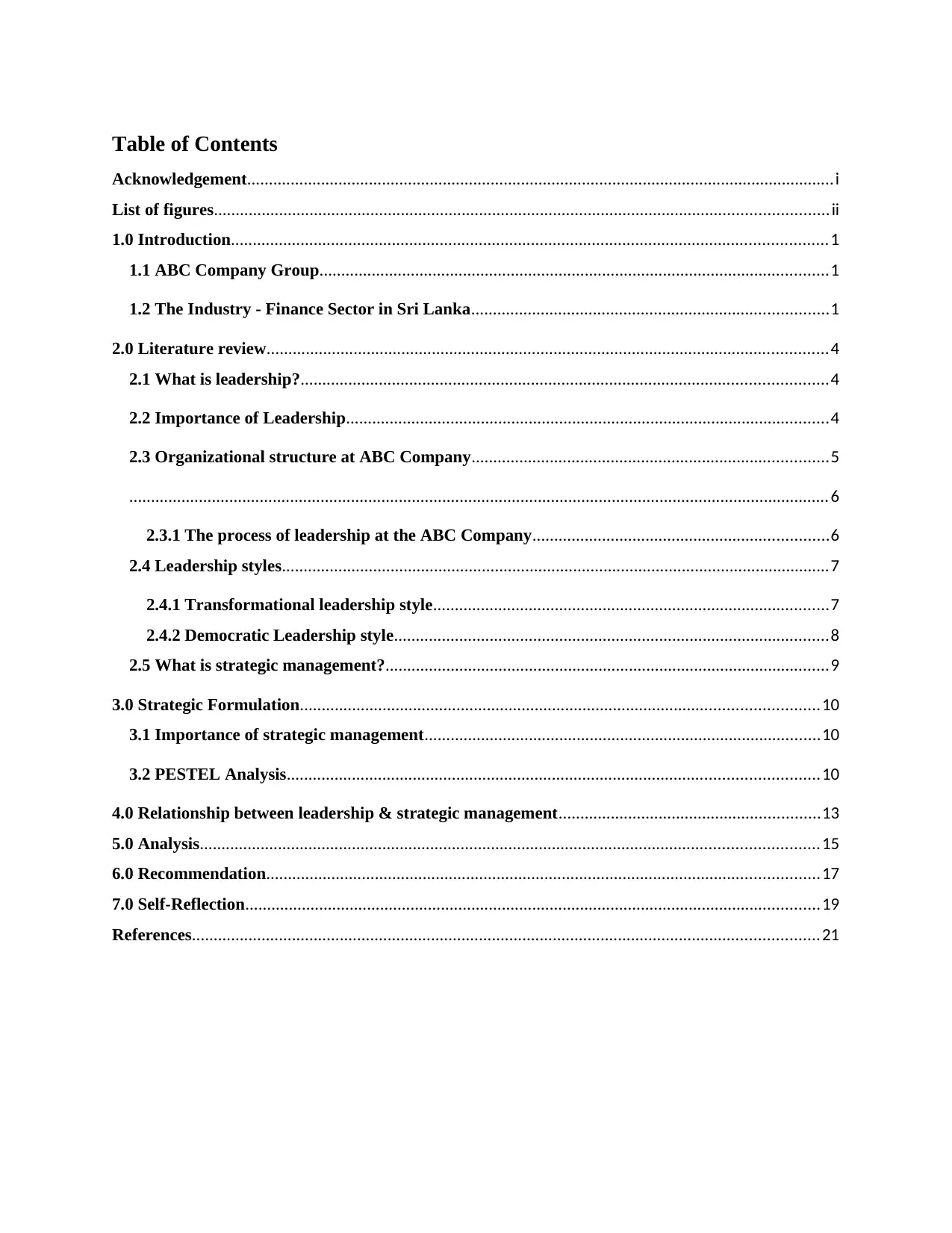
Table of Contents
Acknowledgement.......................................................................................................................................i
List of figures.............................................................................................................................................ii
1.0 Introduction.........................................................................................................................................1
1.1 ABC Company Group.....................................................................................................................1
1.2 The Industry - Finance Sector in Sri Lanka..................................................................................1
2.0 Literature review.................................................................................................................................4
2.1 What is leadership?.........................................................................................................................4
2.2 Importance of Leadership...............................................................................................................4
2.3 Organizational structure at ABC Company..................................................................................5
.................................................................................................................................................................6
2.3.1 The process of leadership at the ABC Company....................................................................6
2.4 Leadership styles..............................................................................................................................7
2.4.1 Transformational leadership style...........................................................................................7
2.4.2 Democratic Leadership style....................................................................................................8
2.5 What is strategic management?......................................................................................................9
3.0 Strategic Formulation.......................................................................................................................10
3.1 Importance of strategic management...........................................................................................10
3.2 PESTEL Analysis..........................................................................................................................10
4.0 Relationship between leadership & strategic management............................................................13
5.0 Analysis..............................................................................................................................................15
6.0 Recommendation...............................................................................................................................17
7.0 Self-Reflection....................................................................................................................................19
References................................................................................................................................................21
Acknowledgement.......................................................................................................................................i
List of figures.............................................................................................................................................ii
1.0 Introduction.........................................................................................................................................1
1.1 ABC Company Group.....................................................................................................................1
1.2 The Industry - Finance Sector in Sri Lanka..................................................................................1
2.0 Literature review.................................................................................................................................4
2.1 What is leadership?.........................................................................................................................4
2.2 Importance of Leadership...............................................................................................................4
2.3 Organizational structure at ABC Company..................................................................................5
.................................................................................................................................................................6
2.3.1 The process of leadership at the ABC Company....................................................................6
2.4 Leadership styles..............................................................................................................................7
2.4.1 Transformational leadership style...........................................................................................7
2.4.2 Democratic Leadership style....................................................................................................8
2.5 What is strategic management?......................................................................................................9
3.0 Strategic Formulation.......................................................................................................................10
3.1 Importance of strategic management...........................................................................................10
3.2 PESTEL Analysis..........................................................................................................................10
4.0 Relationship between leadership & strategic management............................................................13
5.0 Analysis..............................................................................................................................................15
6.0 Recommendation...............................................................................................................................17
7.0 Self-Reflection....................................................................................................................................19
References................................................................................................................................................21
⊘ This is a preview!⊘
Do you want full access?
Subscribe today to unlock all pages.

Trusted by 1+ million students worldwide

List of figures
Figure 1: Organizational structure...............................................................................................................5
Figure 1: Organizational structure...............................................................................................................5
Paraphrase This Document
Need a fresh take? Get an instant paraphrase of this document with our AI Paraphraser

List of Tables
Table 1: SWOT Analyses..........................................................................................................................12
Table 2: Recommendations.......................................................................................................................18
Table 1: SWOT Analyses..........................................................................................................................12
Table 2: Recommendations.......................................................................................................................18
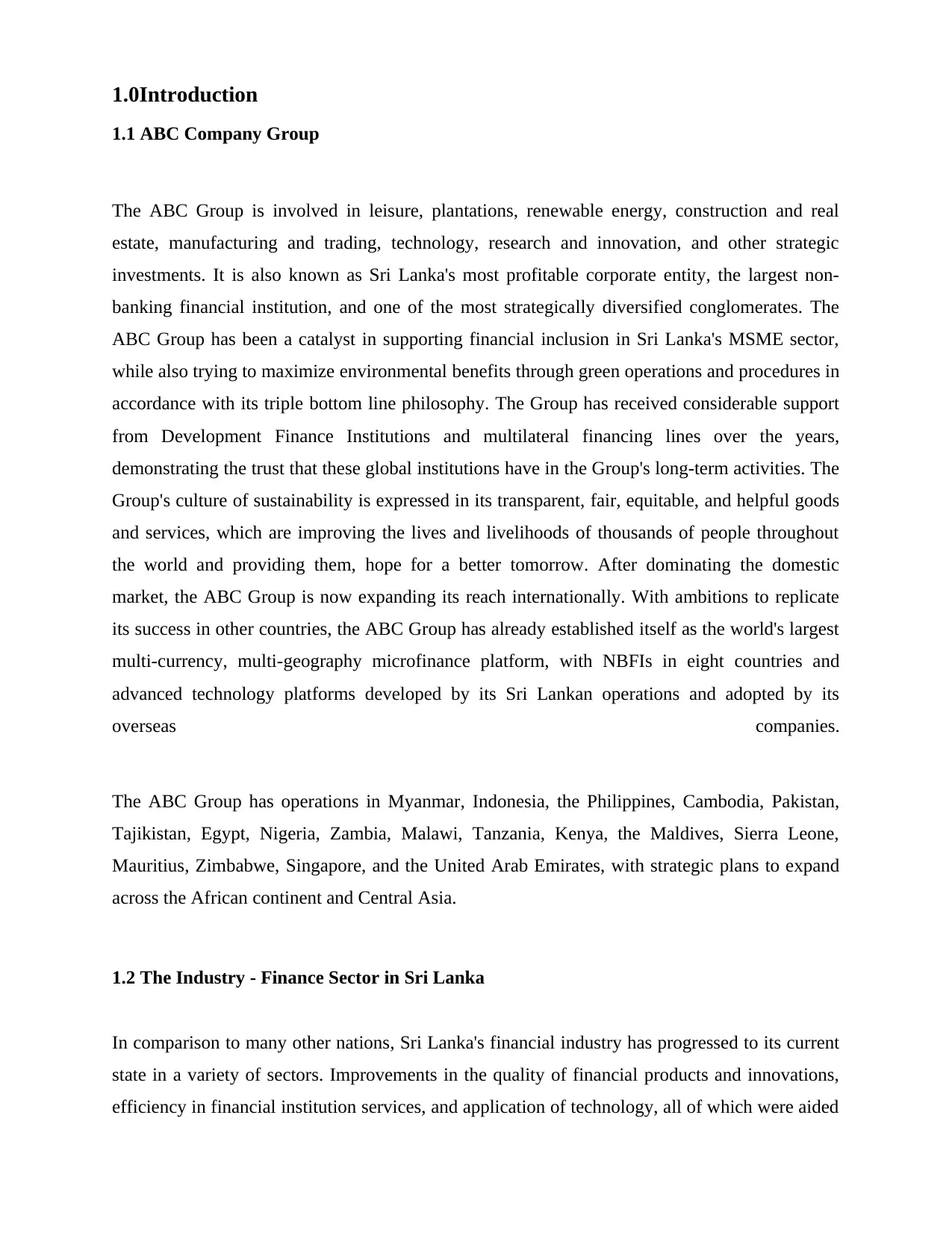
1.0Introduction
1.1 ABC Company Group
The ABC Group is involved in leisure, plantations, renewable energy, construction and real
estate, manufacturing and trading, technology, research and innovation, and other strategic
investments. It is also known as Sri Lanka's most profitable corporate entity, the largest non-
banking financial institution, and one of the most strategically diversified conglomerates. The
ABC Group has been a catalyst in supporting financial inclusion in Sri Lanka's MSME sector,
while also trying to maximize environmental benefits through green operations and procedures in
accordance with its triple bottom line philosophy. The Group has received considerable support
from Development Finance Institutions and multilateral financing lines over the years,
demonstrating the trust that these global institutions have in the Group's long-term activities. The
Group's culture of sustainability is expressed in its transparent, fair, equitable, and helpful goods
and services, which are improving the lives and livelihoods of thousands of people throughout
the world and providing them, hope for a better tomorrow. After dominating the domestic
market, the ABC Group is now expanding its reach internationally. With ambitions to replicate
its success in other countries, the ABC Group has already established itself as the world's largest
multi-currency, multi-geography microfinance platform, with NBFIs in eight countries and
advanced technology platforms developed by its Sri Lankan operations and adopted by its
overseas companies.
The ABC Group has operations in Myanmar, Indonesia, the Philippines, Cambodia, Pakistan,
Tajikistan, Egypt, Nigeria, Zambia, Malawi, Tanzania, Kenya, the Maldives, Sierra Leone,
Mauritius, Zimbabwe, Singapore, and the United Arab Emirates, with strategic plans to expand
across the African continent and Central Asia.
1.2 The Industry - Finance Sector in Sri Lanka
In comparison to many other nations, Sri Lanka's financial industry has progressed to its current
state in a variety of sectors. Improvements in the quality of financial products and innovations,
efficiency in financial institution services, and application of technology, all of which were aided
1.1 ABC Company Group
The ABC Group is involved in leisure, plantations, renewable energy, construction and real
estate, manufacturing and trading, technology, research and innovation, and other strategic
investments. It is also known as Sri Lanka's most profitable corporate entity, the largest non-
banking financial institution, and one of the most strategically diversified conglomerates. The
ABC Group has been a catalyst in supporting financial inclusion in Sri Lanka's MSME sector,
while also trying to maximize environmental benefits through green operations and procedures in
accordance with its triple bottom line philosophy. The Group has received considerable support
from Development Finance Institutions and multilateral financing lines over the years,
demonstrating the trust that these global institutions have in the Group's long-term activities. The
Group's culture of sustainability is expressed in its transparent, fair, equitable, and helpful goods
and services, which are improving the lives and livelihoods of thousands of people throughout
the world and providing them, hope for a better tomorrow. After dominating the domestic
market, the ABC Group is now expanding its reach internationally. With ambitions to replicate
its success in other countries, the ABC Group has already established itself as the world's largest
multi-currency, multi-geography microfinance platform, with NBFIs in eight countries and
advanced technology platforms developed by its Sri Lankan operations and adopted by its
overseas companies.
The ABC Group has operations in Myanmar, Indonesia, the Philippines, Cambodia, Pakistan,
Tajikistan, Egypt, Nigeria, Zambia, Malawi, Tanzania, Kenya, the Maldives, Sierra Leone,
Mauritius, Zimbabwe, Singapore, and the United Arab Emirates, with strategic plans to expand
across the African continent and Central Asia.
1.2 The Industry - Finance Sector in Sri Lanka
In comparison to many other nations, Sri Lanka's financial industry has progressed to its current
state in a variety of sectors. Improvements in the quality of financial products and innovations,
efficiency in financial institution services, and application of technology, all of which were aided
⊘ This is a preview!⊘
Do you want full access?
Subscribe today to unlock all pages.

Trusted by 1+ million students worldwide
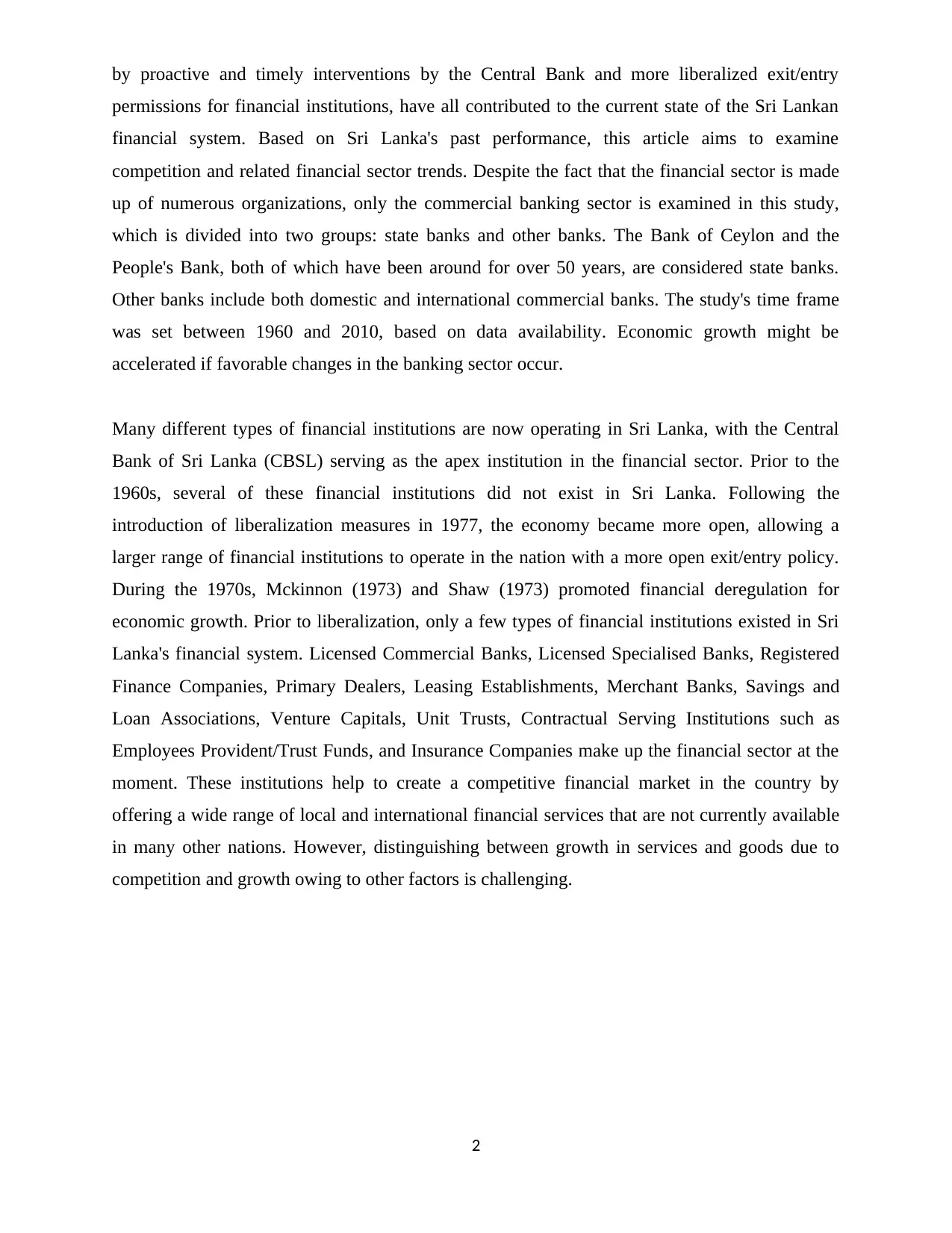
by proactive and timely interventions by the Central Bank and more liberalized exit/entry
permissions for financial institutions, have all contributed to the current state of the Sri Lankan
financial system. Based on Sri Lanka's past performance, this article aims to examine
competition and related financial sector trends. Despite the fact that the financial sector is made
up of numerous organizations, only the commercial banking sector is examined in this study,
which is divided into two groups: state banks and other banks. The Bank of Ceylon and the
People's Bank, both of which have been around for over 50 years, are considered state banks.
Other banks include both domestic and international commercial banks. The study's time frame
was set between 1960 and 2010, based on data availability. Economic growth might be
accelerated if favorable changes in the banking sector occur.
Many different types of financial institutions are now operating in Sri Lanka, with the Central
Bank of Sri Lanka (CBSL) serving as the apex institution in the financial sector. Prior to the
1960s, several of these financial institutions did not exist in Sri Lanka. Following the
introduction of liberalization measures in 1977, the economy became more open, allowing a
larger range of financial institutions to operate in the nation with a more open exit/entry policy.
During the 1970s, Mckinnon (1973) and Shaw (1973) promoted financial deregulation for
economic growth. Prior to liberalization, only a few types of financial institutions existed in Sri
Lanka's financial system. Licensed Commercial Banks, Licensed Specialised Banks, Registered
Finance Companies, Primary Dealers, Leasing Establishments, Merchant Banks, Savings and
Loan Associations, Venture Capitals, Unit Trusts, Contractual Serving Institutions such as
Employees Provident/Trust Funds, and Insurance Companies make up the financial sector at the
moment. These institutions help to create a competitive financial market in the country by
offering a wide range of local and international financial services that are not currently available
in many other nations. However, distinguishing between growth in services and goods due to
competition and growth owing to other factors is challenging.
2
permissions for financial institutions, have all contributed to the current state of the Sri Lankan
financial system. Based on Sri Lanka's past performance, this article aims to examine
competition and related financial sector trends. Despite the fact that the financial sector is made
up of numerous organizations, only the commercial banking sector is examined in this study,
which is divided into two groups: state banks and other banks. The Bank of Ceylon and the
People's Bank, both of which have been around for over 50 years, are considered state banks.
Other banks include both domestic and international commercial banks. The study's time frame
was set between 1960 and 2010, based on data availability. Economic growth might be
accelerated if favorable changes in the banking sector occur.
Many different types of financial institutions are now operating in Sri Lanka, with the Central
Bank of Sri Lanka (CBSL) serving as the apex institution in the financial sector. Prior to the
1960s, several of these financial institutions did not exist in Sri Lanka. Following the
introduction of liberalization measures in 1977, the economy became more open, allowing a
larger range of financial institutions to operate in the nation with a more open exit/entry policy.
During the 1970s, Mckinnon (1973) and Shaw (1973) promoted financial deregulation for
economic growth. Prior to liberalization, only a few types of financial institutions existed in Sri
Lanka's financial system. Licensed Commercial Banks, Licensed Specialised Banks, Registered
Finance Companies, Primary Dealers, Leasing Establishments, Merchant Banks, Savings and
Loan Associations, Venture Capitals, Unit Trusts, Contractual Serving Institutions such as
Employees Provident/Trust Funds, and Insurance Companies make up the financial sector at the
moment. These institutions help to create a competitive financial market in the country by
offering a wide range of local and international financial services that are not currently available
in many other nations. However, distinguishing between growth in services and goods due to
competition and growth owing to other factors is challenging.
2
Paraphrase This Document
Need a fresh take? Get an instant paraphrase of this document with our AI Paraphraser
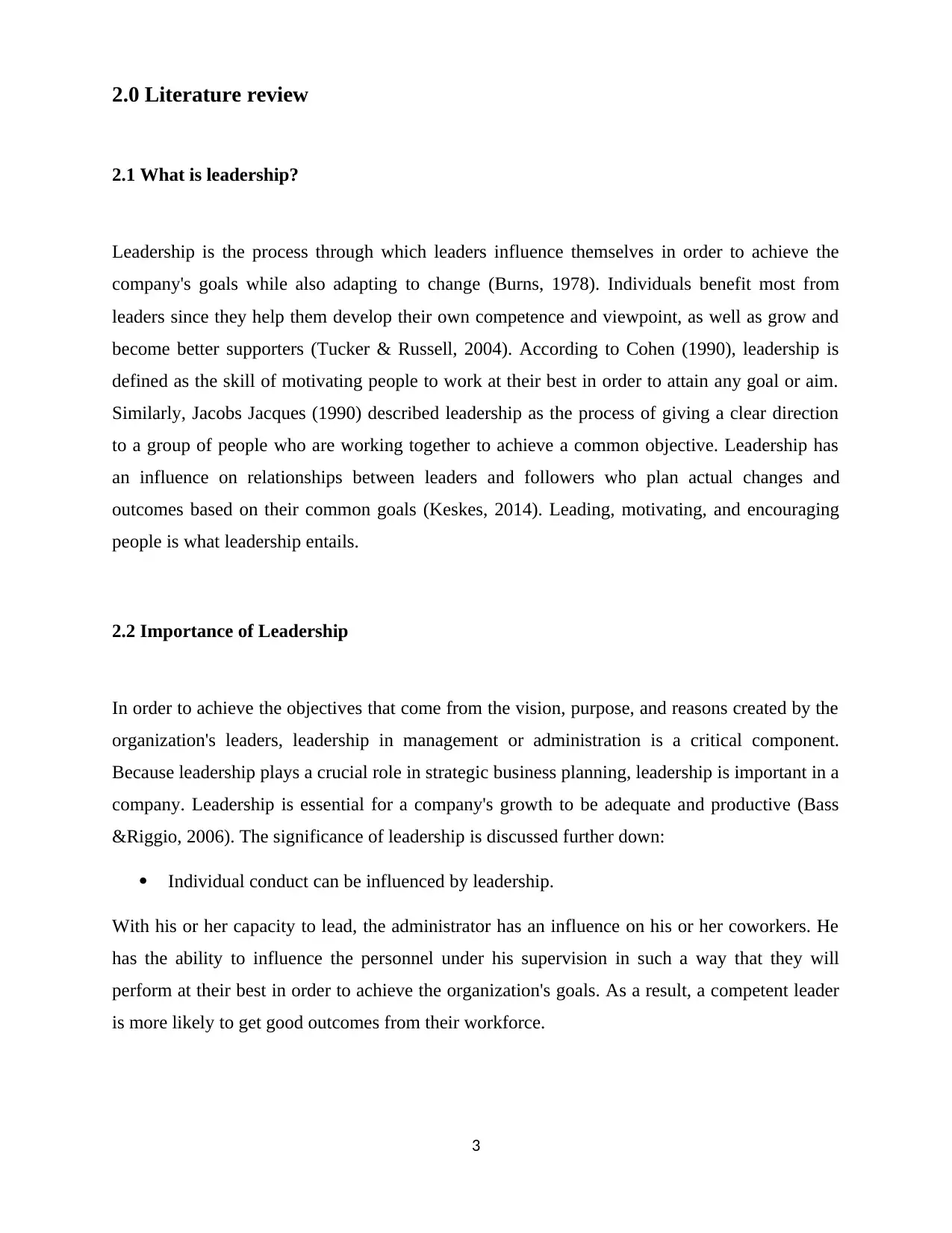
2.0 Literature review
2.1 What is leadership?
Leadership is the process through which leaders influence themselves in order to achieve the
company's goals while also adapting to change (Burns, 1978). Individuals benefit most from
leaders since they help them develop their own competence and viewpoint, as well as grow and
become better supporters (Tucker & Russell, 2004). According to Cohen (1990), leadership is
defined as the skill of motivating people to work at their best in order to attain any goal or aim.
Similarly, Jacobs Jacques (1990) described leadership as the process of giving a clear direction
to a group of people who are working together to achieve a common objective. Leadership has
an influence on relationships between leaders and followers who plan actual changes and
outcomes based on their common goals (Keskes, 2014). Leading, motivating, and encouraging
people is what leadership entails.
2.2 Importance of Leadership
In order to achieve the objectives that come from the vision, purpose, and reasons created by the
organization's leaders, leadership in management or administration is a critical component.
Because leadership plays a crucial role in strategic business planning, leadership is important in a
company. Leadership is essential for a company's growth to be adequate and productive (Bass
&Riggio, 2006). The significance of leadership is discussed further down:
Individual conduct can be influenced by leadership.
With his or her capacity to lead, the administrator has an influence on his or her coworkers. He
has the ability to influence the personnel under his supervision in such a way that they will
perform at their best in order to achieve the organization's goals. As a result, a competent leader
is more likely to get good outcomes from their workforce.
3
2.1 What is leadership?
Leadership is the process through which leaders influence themselves in order to achieve the
company's goals while also adapting to change (Burns, 1978). Individuals benefit most from
leaders since they help them develop their own competence and viewpoint, as well as grow and
become better supporters (Tucker & Russell, 2004). According to Cohen (1990), leadership is
defined as the skill of motivating people to work at their best in order to attain any goal or aim.
Similarly, Jacobs Jacques (1990) described leadership as the process of giving a clear direction
to a group of people who are working together to achieve a common objective. Leadership has
an influence on relationships between leaders and followers who plan actual changes and
outcomes based on their common goals (Keskes, 2014). Leading, motivating, and encouraging
people is what leadership entails.
2.2 Importance of Leadership
In order to achieve the objectives that come from the vision, purpose, and reasons created by the
organization's leaders, leadership in management or administration is a critical component.
Because leadership plays a crucial role in strategic business planning, leadership is important in a
company. Leadership is essential for a company's growth to be adequate and productive (Bass
&Riggio, 2006). The significance of leadership is discussed further down:
Individual conduct can be influenced by leadership.
With his or her capacity to lead, the administrator has an influence on his or her coworkers. He
has the ability to influence the personnel under his supervision in such a way that they will
perform at their best in order to achieve the organization's goals. As a result, a competent leader
is more likely to get good outcomes from their workforce.
3
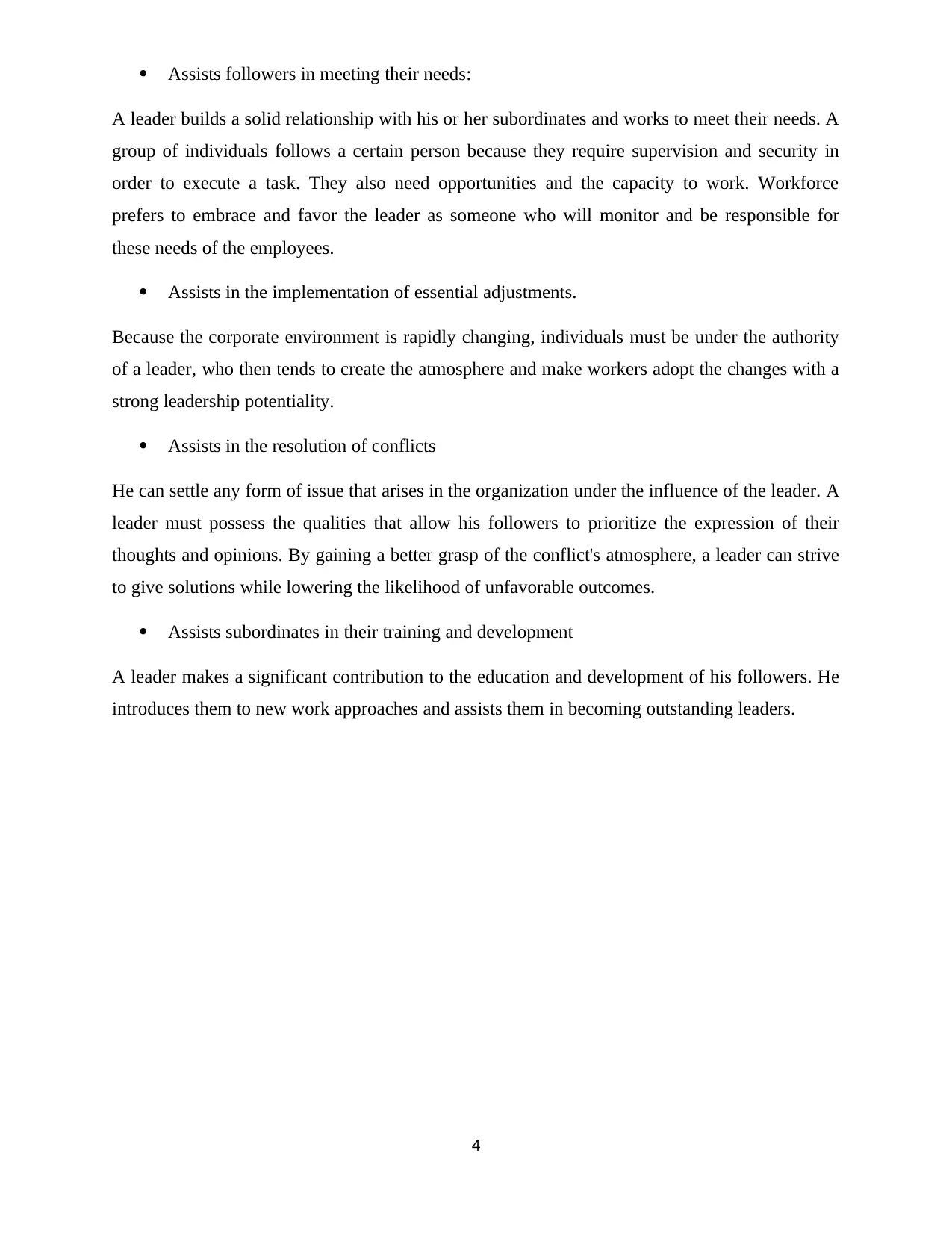
Assists followers in meeting their needs:
A leader builds a solid relationship with his or her subordinates and works to meet their needs. A
group of individuals follows a certain person because they require supervision and security in
order to execute a task. They also need opportunities and the capacity to work. Workforce
prefers to embrace and favor the leader as someone who will monitor and be responsible for
these needs of the employees.
Assists in the implementation of essential adjustments.
Because the corporate environment is rapidly changing, individuals must be under the authority
of a leader, who then tends to create the atmosphere and make workers adopt the changes with a
strong leadership potentiality.
Assists in the resolution of conflicts
He can settle any form of issue that arises in the organization under the influence of the leader. A
leader must possess the qualities that allow his followers to prioritize the expression of their
thoughts and opinions. By gaining a better grasp of the conflict's atmosphere, a leader can strive
to give solutions while lowering the likelihood of unfavorable outcomes.
Assists subordinates in their training and development
A leader makes a significant contribution to the education and development of his followers. He
introduces them to new work approaches and assists them in becoming outstanding leaders.
4
A leader builds a solid relationship with his or her subordinates and works to meet their needs. A
group of individuals follows a certain person because they require supervision and security in
order to execute a task. They also need opportunities and the capacity to work. Workforce
prefers to embrace and favor the leader as someone who will monitor and be responsible for
these needs of the employees.
Assists in the implementation of essential adjustments.
Because the corporate environment is rapidly changing, individuals must be under the authority
of a leader, who then tends to create the atmosphere and make workers adopt the changes with a
strong leadership potentiality.
Assists in the resolution of conflicts
He can settle any form of issue that arises in the organization under the influence of the leader. A
leader must possess the qualities that allow his followers to prioritize the expression of their
thoughts and opinions. By gaining a better grasp of the conflict's atmosphere, a leader can strive
to give solutions while lowering the likelihood of unfavorable outcomes.
Assists subordinates in their training and development
A leader makes a significant contribution to the education and development of his followers. He
introduces them to new work approaches and assists them in becoming outstanding leaders.
4
⊘ This is a preview!⊘
Do you want full access?
Subscribe today to unlock all pages.

Trusted by 1+ million students worldwide
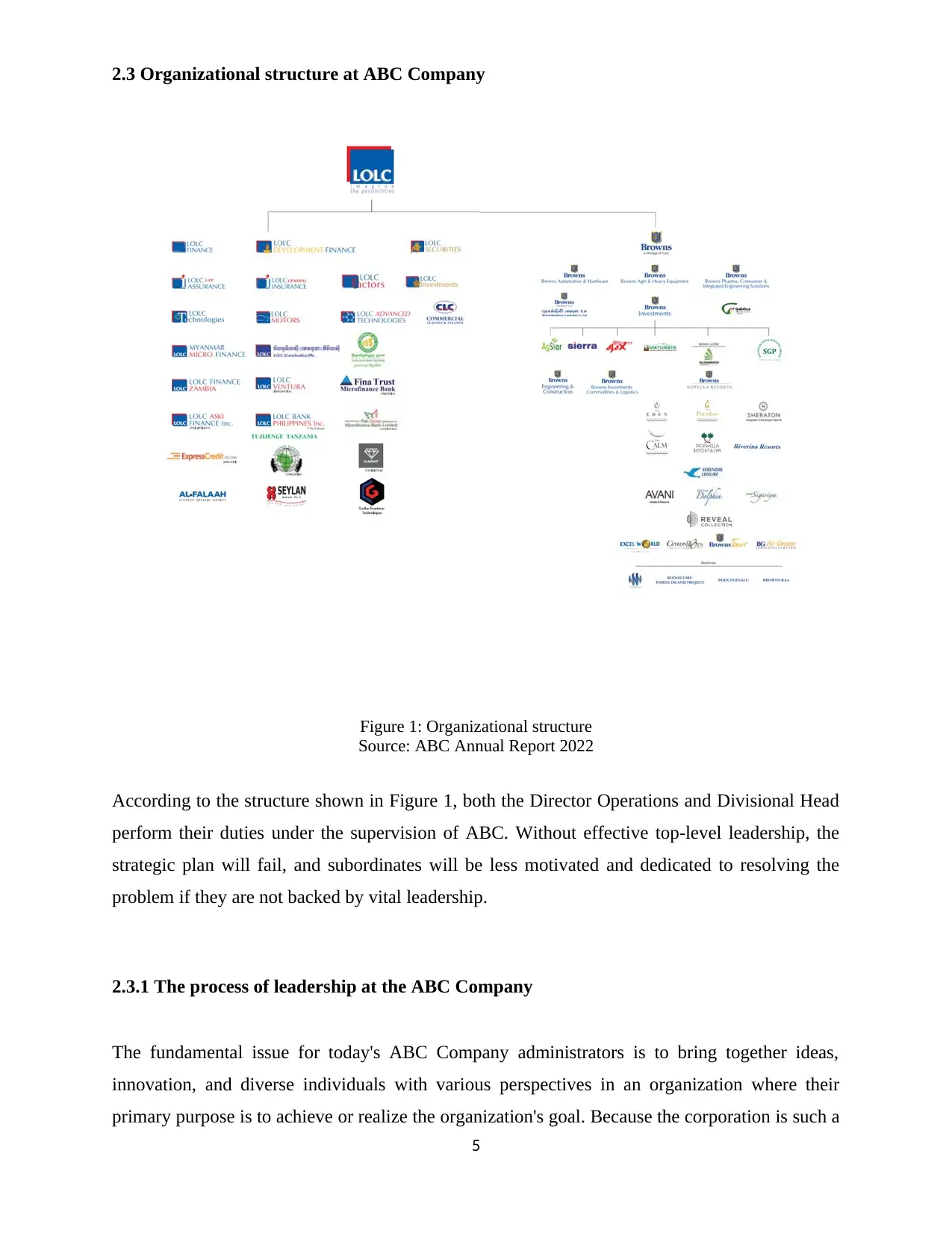
2.3 Organizational structure at ABC Company
Figure 1: Organizational structure
Source: ABC Annual Report 2022
According to the structure shown in Figure 1, both the Director Operations and Divisional Head
perform their duties under the supervision of ABC. Without effective top-level leadership, the
strategic plan will fail, and subordinates will be less motivated and dedicated to resolving the
problem if they are not backed by vital leadership.
2.3.1 The process of leadership at the ABC Company
The fundamental issue for today's ABC Company administrators is to bring together ideas,
innovation, and diverse individuals with various perspectives in an organization where their
primary purpose is to achieve or realize the organization's goal. Because the corporation is such a
5
Figure 1: Organizational structure
Source: ABC Annual Report 2022
According to the structure shown in Figure 1, both the Director Operations and Divisional Head
perform their duties under the supervision of ABC. Without effective top-level leadership, the
strategic plan will fail, and subordinates will be less motivated and dedicated to resolving the
problem if they are not backed by vital leadership.
2.3.1 The process of leadership at the ABC Company
The fundamental issue for today's ABC Company administrators is to bring together ideas,
innovation, and diverse individuals with various perspectives in an organization where their
primary purpose is to achieve or realize the organization's goal. Because the corporation is such a
5
Paraphrase This Document
Need a fresh take? Get an instant paraphrase of this document with our AI Paraphraser
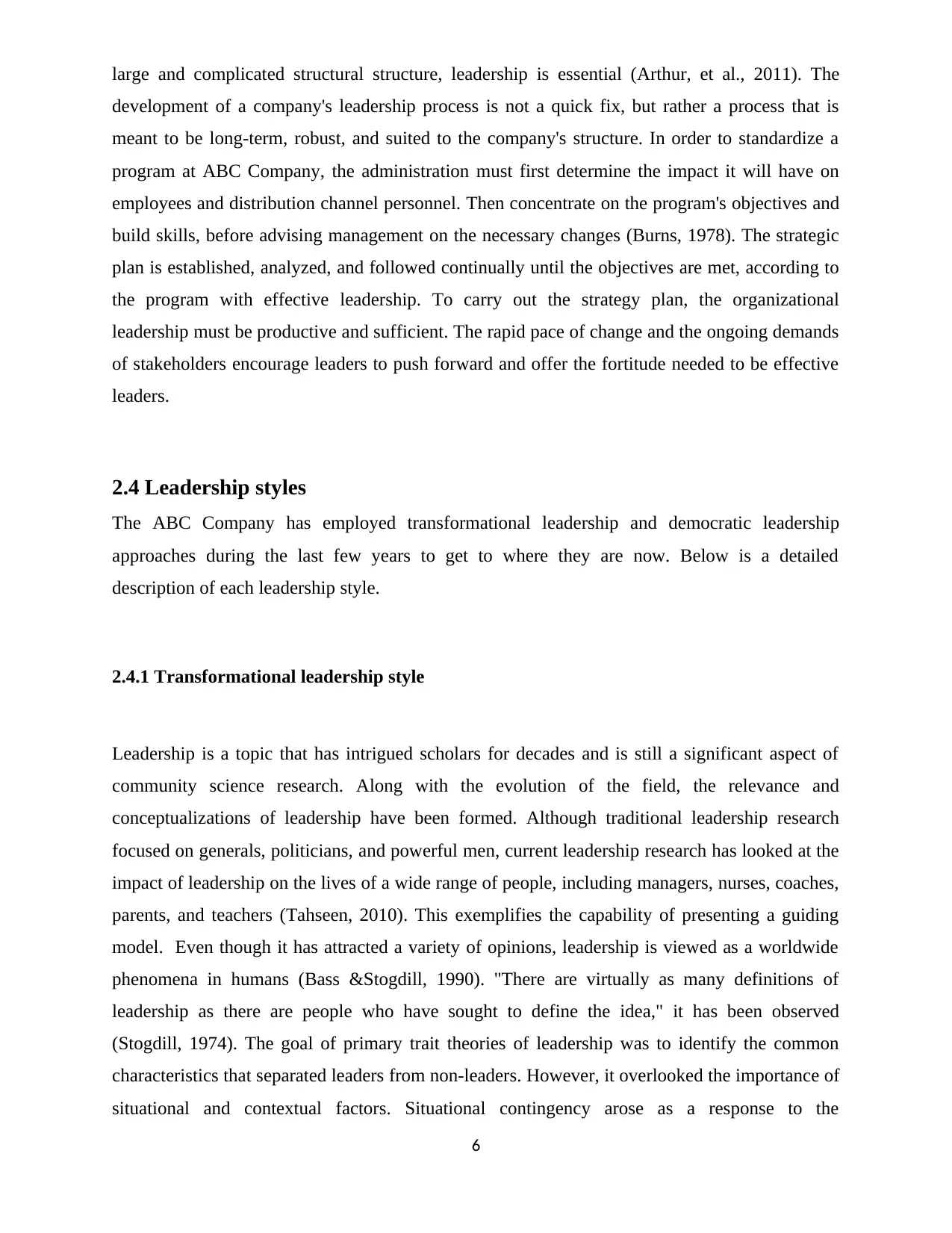
large and complicated structural structure, leadership is essential (Arthur, et al., 2011). The
development of a company's leadership process is not a quick fix, but rather a process that is
meant to be long-term, robust, and suited to the company's structure. In order to standardize a
program at ABC Company, the administration must first determine the impact it will have on
employees and distribution channel personnel. Then concentrate on the program's objectives and
build skills, before advising management on the necessary changes (Burns, 1978). The strategic
plan is established, analyzed, and followed continually until the objectives are met, according to
the program with effective leadership. To carry out the strategy plan, the organizational
leadership must be productive and sufficient. The rapid pace of change and the ongoing demands
of stakeholders encourage leaders to push forward and offer the fortitude needed to be effective
leaders.
2.4 Leadership styles
The ABC Company has employed transformational leadership and democratic leadership
approaches during the last few years to get to where they are now. Below is a detailed
description of each leadership style.
2.4.1 Transformational leadership style
Leadership is a topic that has intrigued scholars for decades and is still a significant aspect of
community science research. Along with the evolution of the field, the relevance and
conceptualizations of leadership have been formed. Although traditional leadership research
focused on generals, politicians, and powerful men, current leadership research has looked at the
impact of leadership on the lives of a wide range of people, including managers, nurses, coaches,
parents, and teachers (Tahseen, 2010). This exemplifies the capability of presenting a guiding
model. Even though it has attracted a variety of opinions, leadership is viewed as a worldwide
phenomena in humans (Bass &Stogdill, 1990). "There are virtually as many definitions of
leadership as there are people who have sought to define the idea," it has been observed
(Stogdill, 1974). The goal of primary trait theories of leadership was to identify the common
characteristics that separated leaders from non-leaders. However, it overlooked the importance of
situational and contextual factors. Situational contingency arose as a response to the
6
development of a company's leadership process is not a quick fix, but rather a process that is
meant to be long-term, robust, and suited to the company's structure. In order to standardize a
program at ABC Company, the administration must first determine the impact it will have on
employees and distribution channel personnel. Then concentrate on the program's objectives and
build skills, before advising management on the necessary changes (Burns, 1978). The strategic
plan is established, analyzed, and followed continually until the objectives are met, according to
the program with effective leadership. To carry out the strategy plan, the organizational
leadership must be productive and sufficient. The rapid pace of change and the ongoing demands
of stakeholders encourage leaders to push forward and offer the fortitude needed to be effective
leaders.
2.4 Leadership styles
The ABC Company has employed transformational leadership and democratic leadership
approaches during the last few years to get to where they are now. Below is a detailed
description of each leadership style.
2.4.1 Transformational leadership style
Leadership is a topic that has intrigued scholars for decades and is still a significant aspect of
community science research. Along with the evolution of the field, the relevance and
conceptualizations of leadership have been formed. Although traditional leadership research
focused on generals, politicians, and powerful men, current leadership research has looked at the
impact of leadership on the lives of a wide range of people, including managers, nurses, coaches,
parents, and teachers (Tahseen, 2010). This exemplifies the capability of presenting a guiding
model. Even though it has attracted a variety of opinions, leadership is viewed as a worldwide
phenomena in humans (Bass &Stogdill, 1990). "There are virtually as many definitions of
leadership as there are people who have sought to define the idea," it has been observed
(Stogdill, 1974). The goal of primary trait theories of leadership was to identify the common
characteristics that separated leaders from non-leaders. However, it overlooked the importance of
situational and contextual factors. Situational contingency arose as a response to the
6
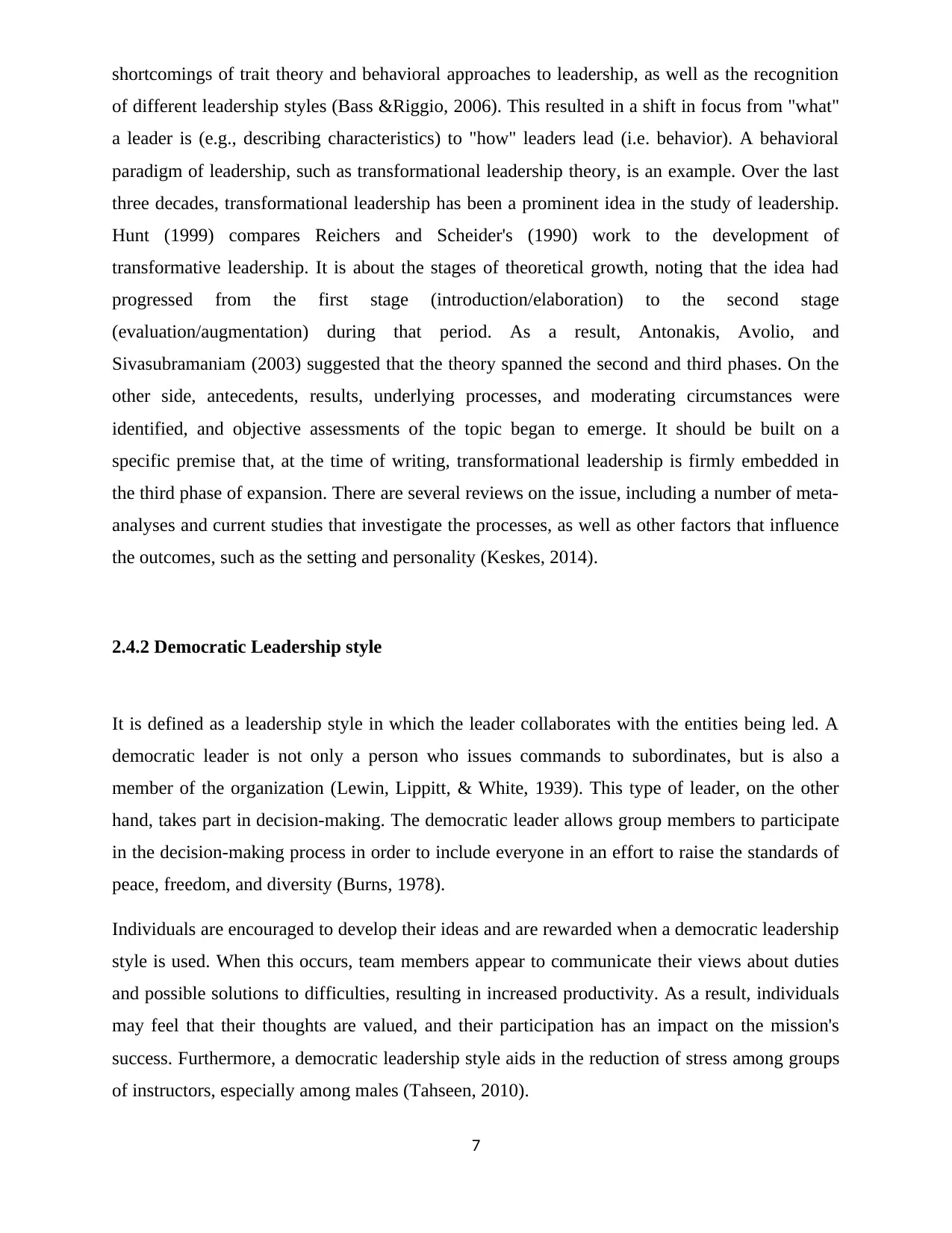
shortcomings of trait theory and behavioral approaches to leadership, as well as the recognition
of different leadership styles (Bass &Riggio, 2006). This resulted in a shift in focus from "what"
a leader is (e.g., describing characteristics) to "how" leaders lead (i.e. behavior). A behavioral
paradigm of leadership, such as transformational leadership theory, is an example. Over the last
three decades, transformational leadership has been a prominent idea in the study of leadership.
Hunt (1999) compares Reichers and Scheider's (1990) work to the development of
transformative leadership. It is about the stages of theoretical growth, noting that the idea had
progressed from the first stage (introduction/elaboration) to the second stage
(evaluation/augmentation) during that period. As a result, Antonakis, Avolio, and
Sivasubramaniam (2003) suggested that the theory spanned the second and third phases. On the
other side, antecedents, results, underlying processes, and moderating circumstances were
identified, and objective assessments of the topic began to emerge. It should be built on a
specific premise that, at the time of writing, transformational leadership is firmly embedded in
the third phase of expansion. There are several reviews on the issue, including a number of meta-
analyses and current studies that investigate the processes, as well as other factors that influence
the outcomes, such as the setting and personality (Keskes, 2014).
2.4.2 Democratic Leadership style
It is defined as a leadership style in which the leader collaborates with the entities being led. A
democratic leader is not only a person who issues commands to subordinates, but is also a
member of the organization (Lewin, Lippitt, & White, 1939). This type of leader, on the other
hand, takes part in decision-making. The democratic leader allows group members to participate
in the decision-making process in order to include everyone in an effort to raise the standards of
peace, freedom, and diversity (Burns, 1978).
Individuals are encouraged to develop their ideas and are rewarded when a democratic leadership
style is used. When this occurs, team members appear to communicate their views about duties
and possible solutions to difficulties, resulting in increased productivity. As a result, individuals
may feel that their thoughts are valued, and their participation has an impact on the mission's
success. Furthermore, a democratic leadership style aids in the reduction of stress among groups
of instructors, especially among males (Tahseen, 2010).
7
of different leadership styles (Bass &Riggio, 2006). This resulted in a shift in focus from "what"
a leader is (e.g., describing characteristics) to "how" leaders lead (i.e. behavior). A behavioral
paradigm of leadership, such as transformational leadership theory, is an example. Over the last
three decades, transformational leadership has been a prominent idea in the study of leadership.
Hunt (1999) compares Reichers and Scheider's (1990) work to the development of
transformative leadership. It is about the stages of theoretical growth, noting that the idea had
progressed from the first stage (introduction/elaboration) to the second stage
(evaluation/augmentation) during that period. As a result, Antonakis, Avolio, and
Sivasubramaniam (2003) suggested that the theory spanned the second and third phases. On the
other side, antecedents, results, underlying processes, and moderating circumstances were
identified, and objective assessments of the topic began to emerge. It should be built on a
specific premise that, at the time of writing, transformational leadership is firmly embedded in
the third phase of expansion. There are several reviews on the issue, including a number of meta-
analyses and current studies that investigate the processes, as well as other factors that influence
the outcomes, such as the setting and personality (Keskes, 2014).
2.4.2 Democratic Leadership style
It is defined as a leadership style in which the leader collaborates with the entities being led. A
democratic leader is not only a person who issues commands to subordinates, but is also a
member of the organization (Lewin, Lippitt, & White, 1939). This type of leader, on the other
hand, takes part in decision-making. The democratic leader allows group members to participate
in the decision-making process in order to include everyone in an effort to raise the standards of
peace, freedom, and diversity (Burns, 1978).
Individuals are encouraged to develop their ideas and are rewarded when a democratic leadership
style is used. When this occurs, team members appear to communicate their views about duties
and possible solutions to difficulties, resulting in increased productivity. As a result, individuals
may feel that their thoughts are valued, and their participation has an impact on the mission's
success. Furthermore, a democratic leadership style aids in the reduction of stress among groups
of instructors, especially among males (Tahseen, 2010).
7
⊘ This is a preview!⊘
Do you want full access?
Subscribe today to unlock all pages.

Trusted by 1+ million students worldwide
1 out of 25
Related Documents
Your All-in-One AI-Powered Toolkit for Academic Success.
+13062052269
info@desklib.com
Available 24*7 on WhatsApp / Email
![[object Object]](/_next/static/media/star-bottom.7253800d.svg)
Unlock your academic potential
Copyright © 2020–2025 A2Z Services. All Rights Reserved. Developed and managed by ZUCOL.





